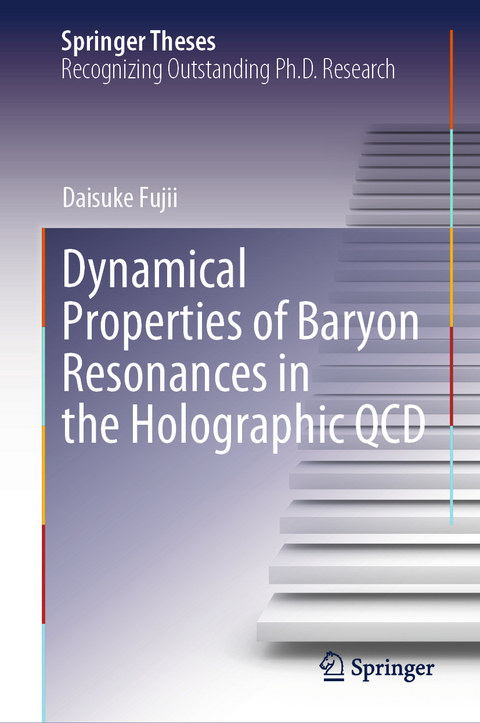
Dynamical Properties of Baryon Resonances in the Holographic QCD
Seiten
2024
|
2024 ed.
Springer Nature (Verlag)
978-981-97-0754-6 (ISBN)
Springer Nature (Verlag)
978-981-97-0754-6 (ISBN)
This book focuses on the study of the dynamical properties of hadron resonances, especially their transition processes by electromagnetic and strong interactions, by using the holographic quantum chromodynamics (QCD) model. Understanding the nature of hadrons leads to revealing non-perturbative phenomena that are prominent in the low-energy region of QCD. However, there remain many open questions regarding the nature of resonant states.
Holographic QCD is one of the most powerful methods to elucidate non-perturbative phenomena in QCD. We will attempt to investigate the dynamical properties of hadron resonances using the Sakai-Sugimoto model, which has achieved much success in the study of hadron physics. In particular, we studied the transition process of hadrons through the calculation of the form factors of them employing the approach of holographic QCD.
The book contains a systematic review of the treatment of hadron physics by the Sakai-Sugimoto model. It further covers how to calculate the form factors of baryons through the calculation of the n-point function from holographic QCD. It also includes remarks on the modern understanding of hadron physics. The method of collective coordinate quantization of solitons—Skyrmion and Instanton—is also explained in a concise manner. These are useful not only for students and young researchers interested in this field.
Holographic QCD is one of the most powerful methods to elucidate non-perturbative phenomena in QCD. We will attempt to investigate the dynamical properties of hadron resonances using the Sakai-Sugimoto model, which has achieved much success in the study of hadron physics. In particular, we studied the transition process of hadrons through the calculation of the form factors of them employing the approach of holographic QCD.
The book contains a systematic review of the treatment of hadron physics by the Sakai-Sugimoto model. It further covers how to calculate the form factors of baryons through the calculation of the n-point function from holographic QCD. It also includes remarks on the modern understanding of hadron physics. The method of collective coordinate quantization of solitons—Skyrmion and Instanton—is also explained in a concise manner. These are useful not only for students and young researchers interested in this field.
Daisuke Fujii is a postdoctoral fellow at the Advanced Science Research Center of the Japan Atomic Energy Agency Sector of Nuclear Science Research. He received his Bachelor of Science in Physics from Tokyo University of Science in 2017, and his Master and Ph.D. in Physics from Osaka University in 2019 and 2023, respectively. His work mainly focuses on the theoretical understanding of hadrons from quantum chromodynamics. The author aims to answer to the puzzle of why nucleons are able to stabilize themselves in the modern era, via the form factor of hadrons.
Introduction.- Hadrons in the Sakai-Sugimoto model.- SU(Nf=2+1) Sakai-Sugimoto model.- Properties of nucleon resonances.- Summary and Outlook.
| Erscheinungsdatum | 03.07.2024 |
|---|---|
| Reihe/Serie | Springer Theses |
| Zusatzinfo | 28 Illustrations, color; 9 Illustrations, black and white; XV, 213 p. 37 illus., 28 illus. in color. |
| Sprache | englisch |
| Maße | 155 x 235 mm |
| Themenwelt | Naturwissenschaften ► Physik / Astronomie ► Atom- / Kern- / Molekularphysik |
| Naturwissenschaften ► Physik / Astronomie ► Hochenergiephysik / Teilchenphysik | |
| Naturwissenschaften ► Physik / Astronomie ► Quantenphysik | |
| Schlagworte | AdS/CFT Correspondence • Dimensional reduction • Form factor • Hadron Physics • instanton • Nucleon • Quantum Chromodynamics • Roper resonance • Sakai-Sugimoto Model • Soliton • Strong Interaction |
| ISBN-10 | 981-97-0754-4 / 9819707544 |
| ISBN-13 | 978-981-97-0754-6 / 9789819707546 |
| Zustand | Neuware |
| Haben Sie eine Frage zum Produkt? |
Mehr entdecken
aus dem Bereich
aus dem Bereich
Buch | Softcover (2024)
Wiley-VCH (Verlag)
59,90 €


